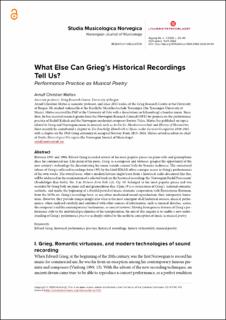| dc.contributor.author | Mattes, Arnulf Christian | |
| dc.date.accessioned | 2021-05-18T12:19:58Z | |
| dc.date.available | 2021-05-18T12:19:58Z | |
| dc.date.created | 2020-10-09T13:54:55Z | |
| dc.date.issued | 2020 | |
| dc.Published | Studia Musicologica Norvegica. 2020, 46 (1), 25-40. | |
| dc.identifier.issn | 0332-5024 | |
| dc.identifier.uri | https://hdl.handle.net/11250/2755485 | |
| dc.description.abstract | Between 1903 and 1906, Edvard Grieg recorded several of his most popular pieces on piano rolls and gramophone discs for commercial use. Like many of his peers, Grieg, as a composer and virtuoso, grasped the opportunity of the new century’s technology for disseminating his music outside concert halls for broader audiences. The remastered release of Grieg’s collected recordings from 1992 by the label SIMAX offers a unique access to Grieg’s performances of his own works. The overall issue, what a modern listener might learn from a historical audio document like this, will be addressed in the examination of a selected track on the historical recording: the ‘Norwegian Bridal Procession’ (Brudefølget drar forbi), No. 2 in Pictures from Folk Life, Op. 19, belonged to his most popular pieces and was recorded by Grieg both on piano roll and gramophone disc. Opus 19 is a cornerstone of Grieg’s ‘national romantic’ aesthetic, and marks the beginning of a fruitful period of music-dramatic cooperation with Bjørnstjerne Bjørnson, from the 1870s on. Grieg’s recordings have, as any other mechanical sound reproduction, their interpretive limitations. However, they provide unique insight into what is the most emergent of all historical sources, musical performance, when analysed carefully and combined with other sources of information, such as musical sketches, scores, the composer’s and his contemporaries’ testimonies, or concert reviews. Moving from generic features of Grieg’s performance style to the individual peculiarities of his interpretation, the aim of this inquiry is to enable a new understanding of Grieg’s performance practice as deeply related to the aesthetic conception of music as musical poetry. | en_US |
| dc.language.iso | eng | en_US |
| dc.publisher | Universitetsforlaget | en_US |
| dc.rights | Navngivelse-Ikkekommersiell 4.0 Internasjonal | * |
| dc.rights.uri | http://creativecommons.org/licenses/by-nc/4.0/deed.no | * |
| dc.title | What Else Can Grieg’s Historical Recordings Tell Us? Performance Practice as Musical Poetry | en_US |
| dc.type | Journal article | en_US |
| dc.type | Peer reviewed | en_US |
| dc.description.version | publishedVersion | en_US |
| dc.rights.holder | Copyright 2020 Author(s). | en_US |
| cristin.ispublished | true | |
| cristin.fulltext | original | |
| cristin.qualitycode | 1 | |
| dc.identifier.doi | 10.18261/issn.1504-2960-2020-01-04 | |
| dc.identifier.cristin | 1838495 | |
| dc.source.journal | Studia Musicologica Norvegica | en_US |
| dc.source.40 | 46 | |
| dc.source.14 | 1 | |
| dc.source.pagenumber | 25-40 | en_US |
| dc.subject.nsi | VDP::Musikkvitenskap: 110 | en_US |
| dc.subject.nsi | VDP::Musicology: 110 | en_US |
| dc.identifier.citation | Studia Musicologica Norvegica. 2020, 46 (1), 25-40. | en_US |
| dc.source.volume | 46 | en_US |
| dc.source.issue | 1 | en_US |

